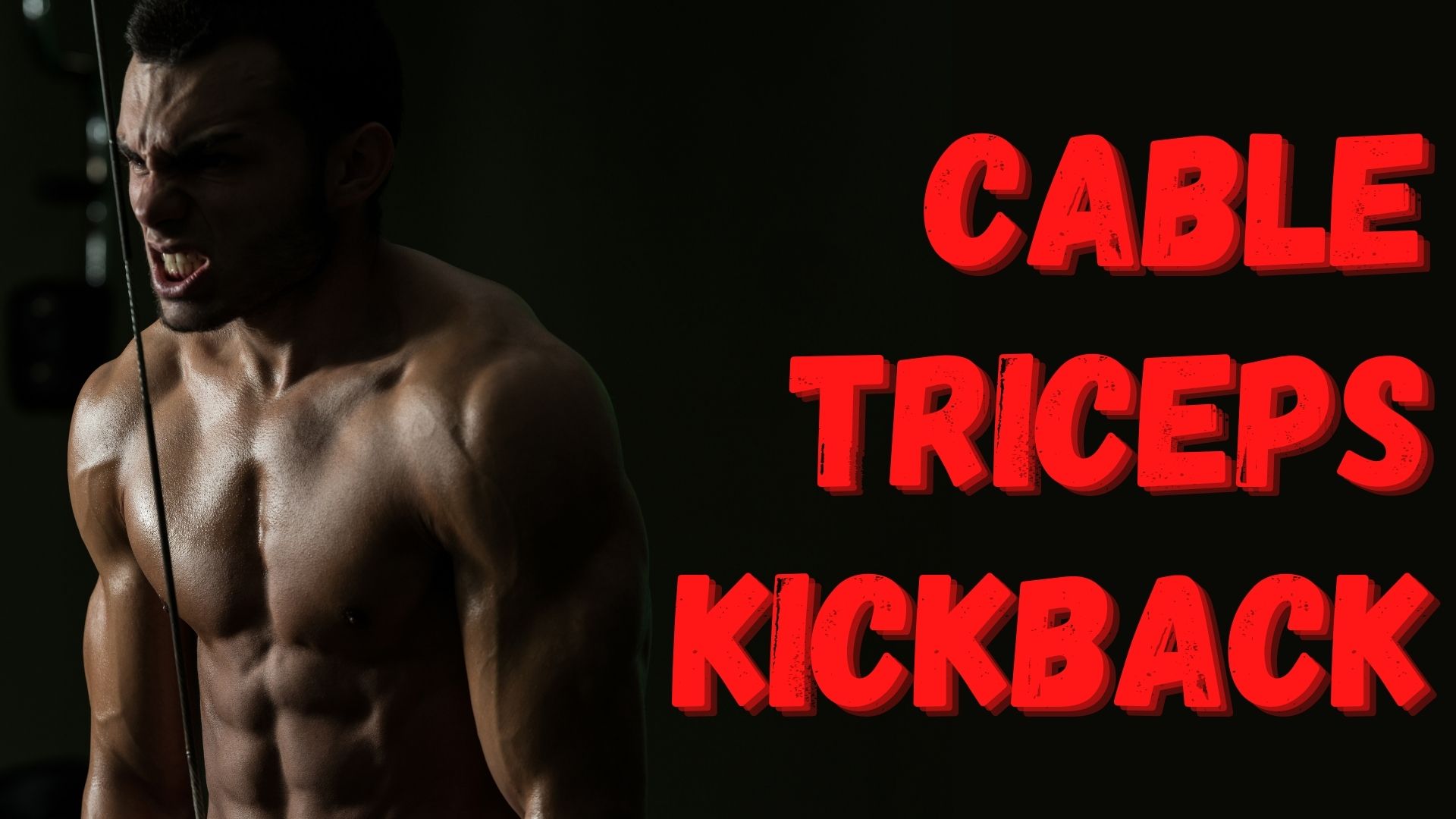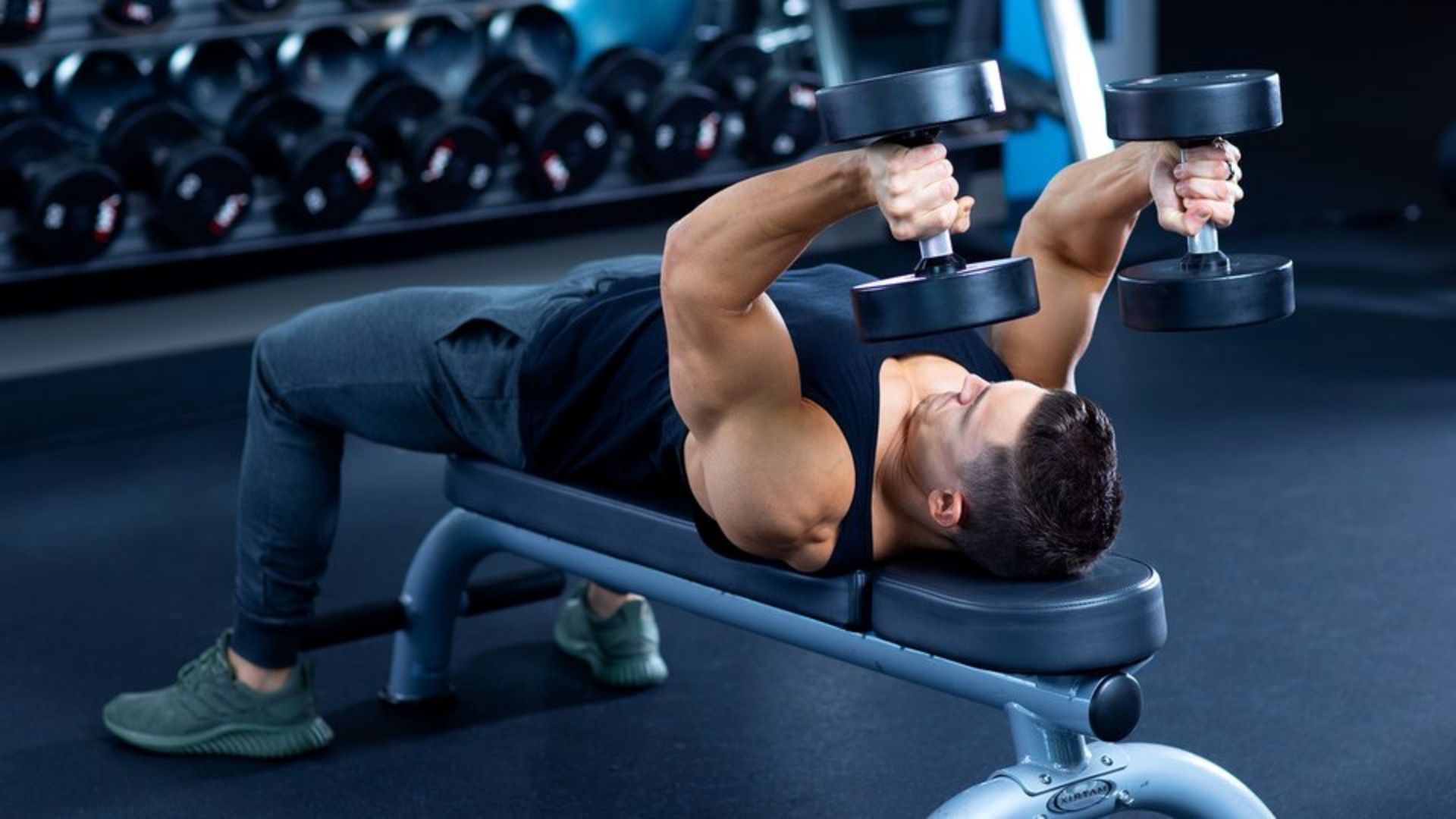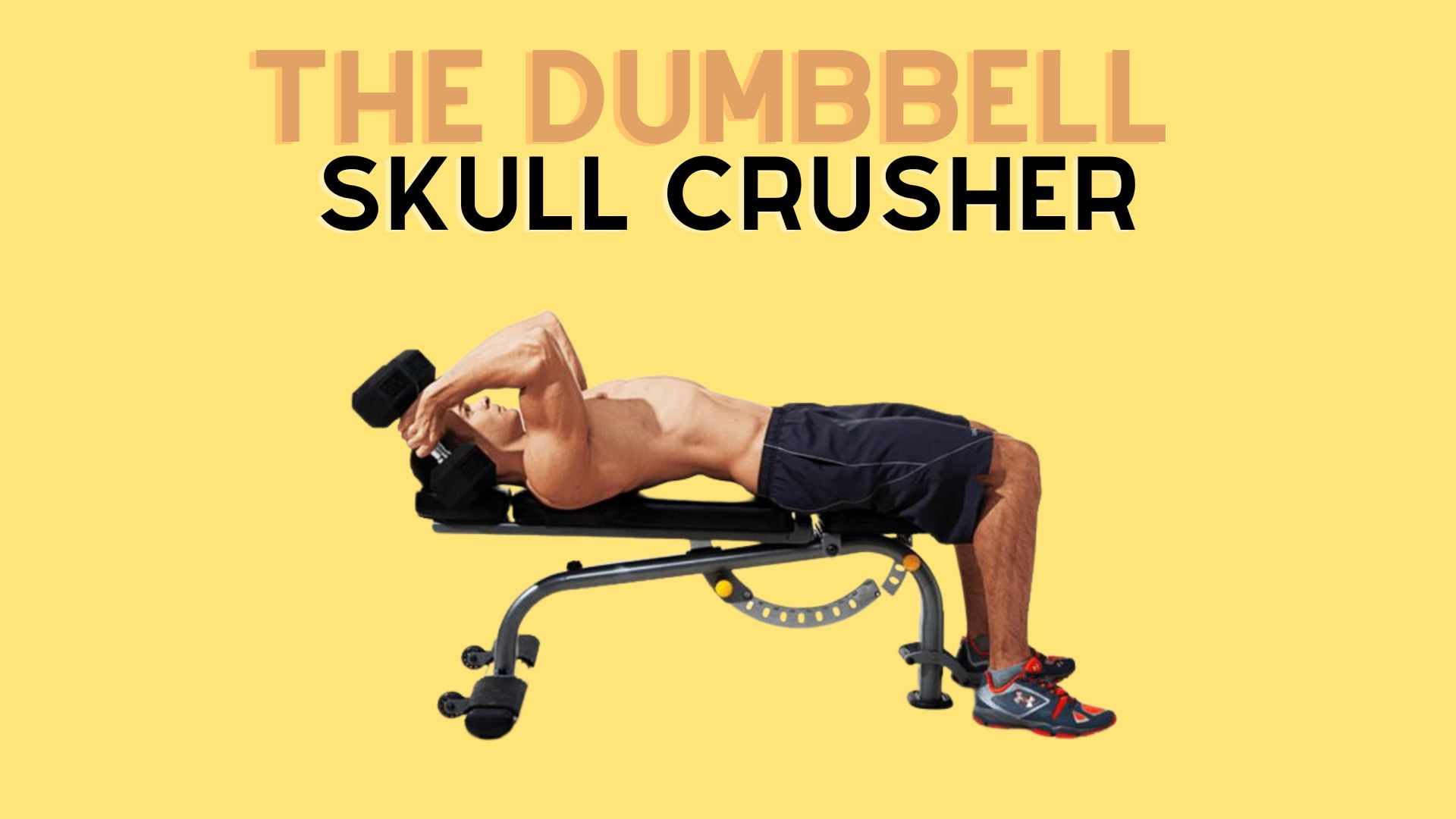
Dumbbell Skull Crusher: The Key to Strong Triceps
The dumbbell skull crushers -no exercise is more frightening than this. Yes, burpees can be difficult; however, their name is safe enough. But, skull crushers are self-inflicted injuries that are written on them.
You’ve probably heard about these, but most people aren’t sure what they’re. They’re a fantastic method of adding weight and definition to your back arms. If you can use the right technique and common sense, they can be done safely with a low risk of injuries.
We’ll give you all the information about the dumbbell skull crusher, what muscles they use, how to do the correct way, what they can do for you, what benefits they bring, and the best way to alter them to suit your equipment and your abilities.
The Dumbbell Skull Crusher
The dumbbell skull crushers, commonly called the lying triceps extension, are a beneficial exercise that can be done by anyone who wants to increase tricep power and strength. The tricep is among the main muscles involved in training for the upper body.
If you’re looking to increase the strength of your upper body and appearance and size, the dumbbell skull crushers are ideal for you!
The Dumbbell Skull Crusher: Working Muscles

Primary Muscle Group
Contrary to what you think, a properly functioning the dumbbell skull crusher won’t, in actual fact, break your skull. Fortunately, the triceps muscle prevents this from occurring. The triceps muscle consists of 3 heads: the long medial, lateral, and long head.
The lying triceps extension is a workout for across all 3 heads; the exercise specifically targets the lateral and long head of the triceps.
Secondary Muscle Group
Although the dumbbell skull crusher is an exercise that isolates your triceps muscles, others muscle groupings are additionally trained. Your shoulders’ front and back deltoids are contracted to stabilize your arms.
The clavicular head of the pectoralis major, which is located within your chest’s upper region, is also a source of tension and helps stabilize your upper body when you are extended triceps flexion lying. Additionally, the latissimus Dorsi, the largest muscle in your back, also plays an important role in stabilization.
The Dumbbell Skull Crusher: Benefits
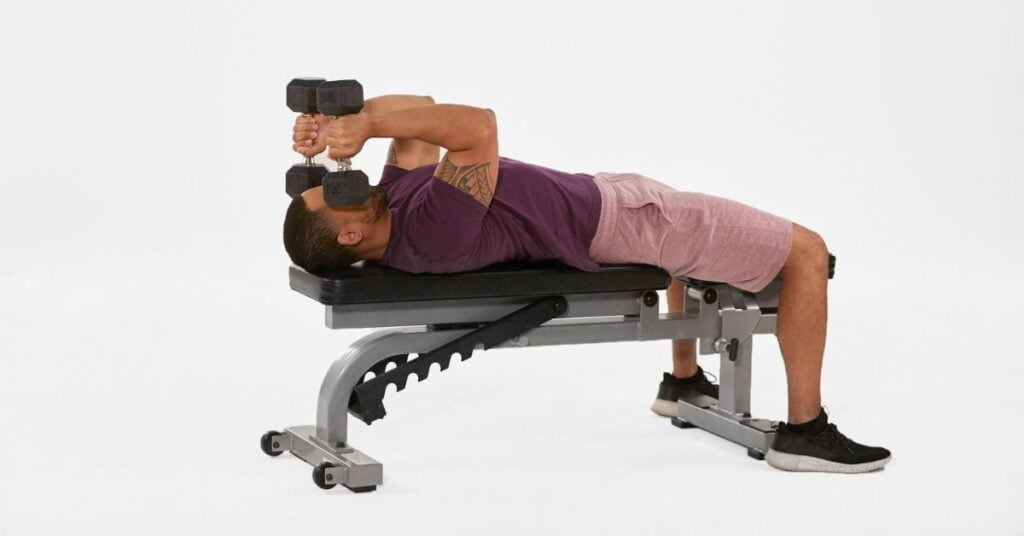
#1 Stronger Triceps
The dumbbell skull crusher is among the top exercises that have been proven to build the triceps muscles. A stronger tricep muscle is vital to complete various other exercises for the upper body. It is difficult to effectively train your shoulders and chest if you don’t have strong muscles in your triceps.
The strength in your triceps increases the strength of your arm as well; it can make you more effective when doing a variety of exercises in the fitness center.
#2 Triceps Isolation
This triceps stretch lying exercise is an exercise that is isolated. This means that unlike other exercises like the bench press or pushup, the dumbbell skull crusher targets the triceps muscle.
This is crucial for athletes, bodybuilders, or any other person who wants to increase the appearance and strength of their triceps.
#3 A Low Stress On The Wrists
Through the dumbbell skull crusher, the wrists remain upright. There isn’t any rotation or extra strain put on your wrists.
If you are having trouble with other demanding exercises such as the close grip barbell or weighted dips that are too uncomfortable, look at the dumbbell skull crusher and relieve tension off your wrists.
The Dumbbell Skull Crusher: Instructions
Equipment
For this workout, you’ll require an exercise dumbbell.
Setup
- Place your body on a bench that is flat or on the ground with your feet solidly on the floor.
- Hold the dumbbells to your chest, with your palms in front of you, and work your core.
Instructions
- With your elbows straight and your elbows in a fixed position, hinge your elbows to gradually lower the dumbbells close to your ear. Inhale.
- Contract your triceps muscles to stretch your arms back to an upright position on top. Exhale.
- Repeat this movement for the desired number of repetitions.
Recommendation
If you’re new to this triceps extension, select a lighter weight and then complete 3-4 sets of 10 to 15 reps. If you are confident with the form, grab a pair of heavier dumbbells. Stick to 6–8 reps for 3-4 sets.
The Dumbbell Skull Crusher: Mistakes

#1 Flooring Of The Elbows
Many weightlifters flare their elbows out when performing the dumbbell skull crusher. When elbows flare, we risk injuring our shoulders and removing tension from our triceps.
Keep your elbows in place to practice correct form.
#2 Excessive Movement Of Shoulders/Elbows
It is important to ensure your elbows are fixed in position in the triceps extensions lying position. People are prone to sway their shoulders back when the weight is lowered most of the time. This causes the elbows to slide backward, too.
While certain movements are natural, excessive movement can cause your lats to work to lift the dumbbells up. If you only want to strengthen your triceps muscles, hold your shoulders and elbows in a seated place.
#3 Archiving Back
The back arching you do when you do the lying triceps extension can affect your stability and body’s posture when you are doing this exercise.
Instead of bending your back, put your feet with a firm grip on the ground, work your core and ensure your back is flat on the bench or the ground.
The Dumbbell Skull Crusher: Variations
#1 Bodyweight Skull Crushers
No equipment? It’s not a problem! You can make the skull crusher using only your body weight. Start by getting into the plank position by putting your hands placed together. You can then contract your triceps and raise your body off the floor and backward.
Return to the plank position, and repeat!
#2 Barbell Skull Crushers
The barbell skull crusher is different from the dumbbell skull crusher. This variation is particularly useful when you are looking to increase the weight of the workout.
#3 1-Arm Skull Crushers
Additionally, you can utilize the skull crusher for training your arms in a specific way to correct any muscle imbalances that could be present within your arms. Make sure your core is engaged to ensure stability during this workout!
The Dumbbell Skull Crusher: Crusher Alternatives
If you’ve enjoyed the dumbbell skull crusher, take a look at these triceps exercises that will help improve your upper body strength:
#1 Alternating Triceps Pushdown
The alternating triceps pulldown is an effective isolation exercise for the triceps. Keep your elbows close to your sides, and then contract your triceps towards the bottom of each repetition.
#2 Overhead Triceps Extension
Extension of your triceps overhead is a great way to strengthen the triceps’ long heads. When you are extending upwards, pull the rope away and tighten your triceps at the upper point of each repetition.
#3 Close Grip Bench Press
The bench press with a close grip is a great exercise for your triceps, and it’s more effective than the standard bench press. Place the weight to just below your chest, and then contract your triceps in a downward direction to push upwards. Repeat!
The Dumbbell Skull Crusher: Sets & Reps
Luckily that it’s not nearly as complicated as the squat or deadlift. This means that you don’t require a lot of programming to benefit from the benefits. Because it’s an isolated exercise, the options for programming may be restricted. However, this doesn’t mean that the dumbbell skull crusher can’t be used in various ways.
The dumbbell skull crusher is designed to be performed using lighter weights. Getting the right form is crucial to maximizing your benefits.
To achieve this, you can set your sights on higher reps. Try to finish three sets of eight to 20 reps, with 1 to 2 minutes of pause between sets.
Muscle Growth: 2 to 4 sets of 8-12 repetitions with a difficult but easily manageable weight.
Endurance: 3 to 4 sets of 15 to 20 reps using an easy weight and only a few minutes of rest.
Beginners: 3 sets of eight reps each with the weight that allows you to concentrate upon your form.
Power: You’ll have to increase your weight and do 4 sets of 4 to 6 reps.
Do not forget that, just like any exercise, it’s advised to rest your muscles for at least 24 hours in between exercise sessions.
Try to incorporate the dumbbell skull crusher routine into your routine regularly.
When Is The Best Time To Do The Dumbbell Skull Crusher In My Training?
Perform the dumbbell skull crusher as early as possible in your arm training. The reason for this is that the dumbbell skull crusher could be loaded with additional weight; it is important to not deprive your body of the possibility to lift heavier weights by pre-fatiguing the muscles of your other exercises.
The Dumbbell Skull Crusher Hurts My Elbows, What Can I Do?
Most likely, it is not the dumbbell skull crusher. If you’re experiencing any discomfort, seek out a physician in the first instance. But, the best rule of thumb is. If it hurts (and it’s not in a normal manner), it’s best to avoid it. Try a variety of cable exercises such as pushdowns. They’re generally more gentle on elbows and shoulder joints.
The Barbell Skull Crusher Vs The Dumbbell Skull Crusher
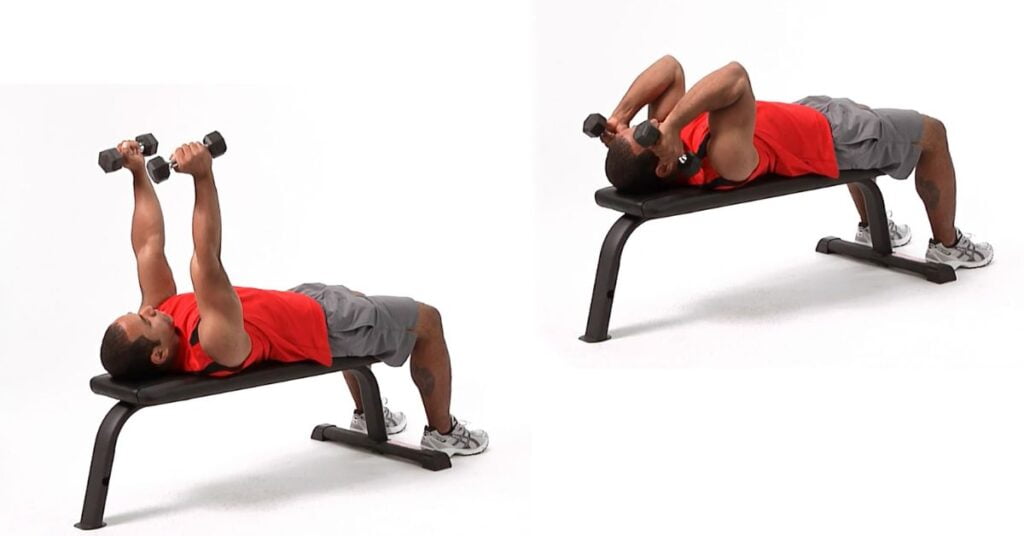
Not necessarily. The goal in this particular exercise, just like any exercise, is to strain the muscle target as effectively as possible. If you feel your muscle is working the way it should, it’s. If not, then explore another exercise. What exercise is the most effective is different for every person? If you aren’t feeling your tris work while using a barbell, consider using a tris handle to an extension cable. Also, make use of a pair of dumbbells. Even kettlebells work. You can play with them.
Who Should Be Aware Of Them?
Before beginning the dumbbell skull crusher, there are some warnings to be aware of. As the name implies, the dumbbell skull crusher require some control to avoid crushing your skull. consequently, I advise my clients to begin with lighter weights to ensure they can manage when they are doing the eccentric (lowering) part of the exercise. If you’re experiencing instability, it’s better, to begin with, tricep exercises such as kickbacks using bands. Additionally, having two dumbbells to perform this exercise isn’t the most secure option if you’ve got the same strength level in each arm.
The dumbbell skull crusher create an enormous amount of strain and stress on elbows and are not recommended if you suffer from tendonitis or pain in the wrist. You’re also placing a lot of strain on the wrist. So take care of your wrists if they are in discomfort.
Last Words
The dumbbell skull crusher is a one-joint exercise designed to work the triceps muscles and are a popular part of an upper-body or push-pull routine. The workout is usually performed on a bench, but it could also be done on a mat, using dumbbells or barbells. The form is crucial for your safety and precision during the execution. You should be sure to maintain the spine in a neutral position and keep your elbows towards the body. Since your body’s stability and control are essential for this exercise, the dumbbell skull crusher need to be built slowly before adding heavier weights. They can also cause the wrist and elbow pain already present, which is why altering or modifying the exercise might be a safer choice.



